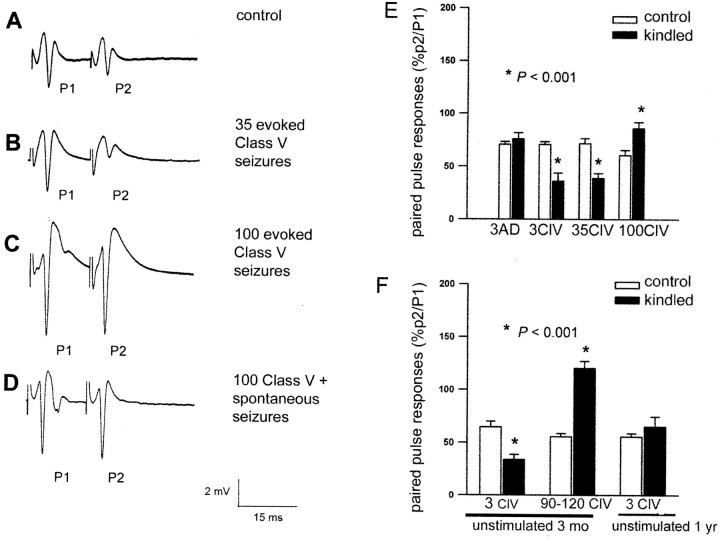Fig. 1.
Evolving alterations in paired-pulse responses in the dentate gyrus of kindled rats as a function of the number of evoked seizures. A, Extracellular field potentials evoked in the dentate gyrus by paired stimuli delivered to fibers of the perforant path at an interpulse pulse interval of 15 msec using the lowest stimulus intensity that evoked a maximal response, as determined by input–output curves. Paired-pulse inhibition is indicated by the reduction in amplitude of the population spike of the second response (P2) compared with the first (P1). Paired-pulse inhibition is present when the ratio P2:P1 is <1. B, In the dentate gyrus from a kindled rat that experienced 35 evoked class V seizures, paired-pulse inhibition was increased compared with the age-matched control in A, as demonstrated by the reduction of the ratio of P2:P1. C, In a kindled rat that experienced 100 evoked class V seizures, there was a reduction of paired-pulse inhibition, as demonstrated by the increase in the ratio of the amplitude of the population spike of the second response (P2) compared with the amplitude of the first population spike (P1).D, In a kindled rat with >100 class V seizures that was also observed to have spontaneous seizures, paired-pulse inhibition was also reduced, as indicated by the increase in the amplitude of the population spike of the second response (P2) compared with the amplitude of the first population spike (P1). E, Evolving alterations in paired-pulse inhibition in the dentate gyrus as a function of the number of evoked seizures. The ratio of the amplitude of the second population spike to the amplitude of first population spike (P2:P1) is expressed as a percentage for kindled rats that experienced a range of three evoked ADs to 100 evoked class V (ClV)seizures (filled bars) compared with age-matched controls (open bars). Paired-pulse inhibition is present when the ratio of P2:P1 is <100%. Paired-pulse inhibition was unchanged after three ADs but increased after 3 or 35 class V seizures, as indicated by a reduction in the ratio P2:P1 compared with controls. Paired-pulse inhibition was reduced compared with age-matched controls after 100 evoked class V seizures, as indicated by an increase in the ratio of P2:P1 compared with age-matched controls. There were no significant differences between kindled rats that received olfactory bulb or perforant-path stimulation. Asterisks indicate significant differences between kindled and age-matched control groups. F, The increase in paired-pulse inhibition was observed at 3 months after the last of three evoked class V seizures but was not observed at 1 year after the last of three evoked class V seizures. In hippocampal slices from kindled rats examined at 3 months after the last of 90–100 evoked class V seizures, there was not only a reduction but also a loss of paired-pulse inhibition as indicated by a ratio of P2:P1 > 100%.

